Social networks make us lonely, and messaging feels transactional. There’s still no vibrant, real-time place to hang out with friends online. That’s why four years after Sean Parker’s chat roulette website Airtime fell flat, he’s reviving it as a mobile chat room where friends can share photos, music, and videos that they all experience simultaneously.
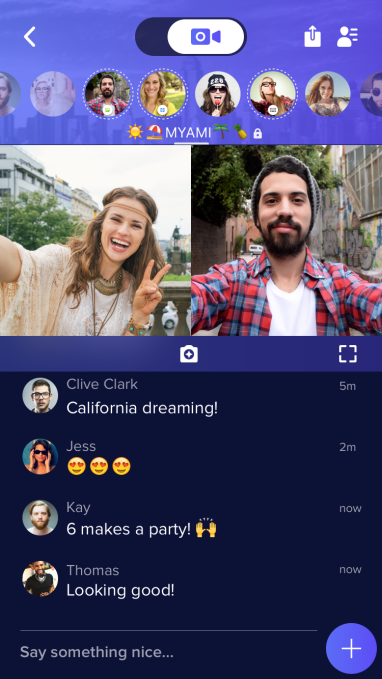 Launching on iOS and Android today, Airtime wants to simulate what it’s like to be in the same room with your favorite people, instead of divided by asynchronous News Feeds where we lob Likes at each other. Parker tells me that unlike broadcast social media, “people can have the expectation of privacy, intimacy, and closeness – a kid of humanity rather than everything having to be some form of theater or performance.”
Launching on iOS and Android today, Airtime wants to simulate what it’s like to be in the same room with your favorite people, instead of divided by asynchronous News Feeds where we lob Likes at each other. Parker tells me that unlike broadcast social media, “people can have the expectation of privacy, intimacy, and closeness – a kid of humanity rather than everything having to be some form of theater or performance.”
At its core, Airtime is about adding 10, 20, or even 50 friends to a room that becomes your persistent third-space online. Pop your head in any time, friends will get notified, and suddenly you’re all talking and experiencing content as if you were crowded around a desktop computer together. You can video chat with up to 6 friends at once and watch everyone’s live thumbnail reactions to what you share.
Airtime is complex to the point of being daunting, though it’s also flexible enough to encompass most ways we express ourselves. Parker says he’ll be patient no matter how long it takes to grow a community for Airtime. But if Facebook Live and Snapchat Chat 2.0 are any indicator, real-time content and a sense of co-presence are where social is going.
You can watch our quick video demo below
Off The Air, Under The Radar
Airtime was founded in 2011 and raised almost $33 million from top investors like Andreessen Horowitz, Accel, GV, Kleiner Perkins, Social Capital, CAA Ventures, and Kevin Colleran.
It premiered a year later with a glitzy, celebrity-filled New York launch event. There was just one problem. “The product didn’t work” Parker admits. Demos crashed, the Facebook invite system refused to function, and the experience of intimately co-watching with a stranger seemed awkward. No one used it.
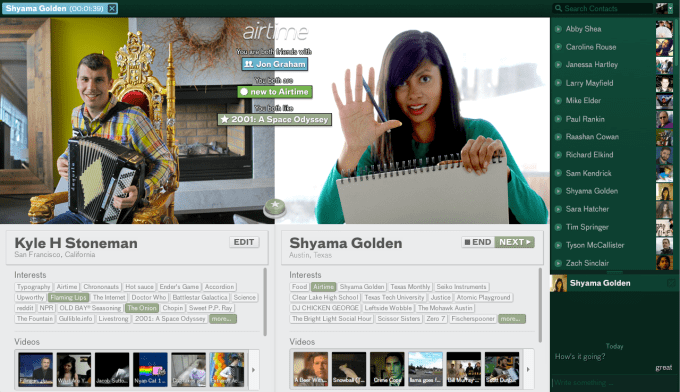
Parker tells me “I wish I hadn’t been forced to launch the original version of Airtime”, but he felt required to by “this philosophy of rapid iteration and that you have to put something in the market.” It hadn’t been thoroughly tested enough for scalability or market fit.
So Parker shut it down, parted ways with his former Napster colleague and Airtime co-founder Shawn Fanning (still a friend and shareholder), and acquired startup studio K2 Labs to help rebuild something people would actually want.
To avoid the press, Airtime tested concepts and versions of its apps in foreign countries under different names. Fortune discovered one of its tests called OK Hello that just did the chat room, not the simultaneous content consumption. But now the full version is ready for its closeup.
Your Digital Clubhouse
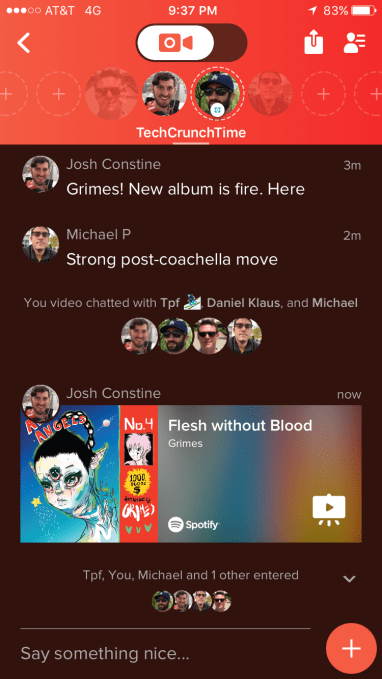 The sense of urgency and liveliness is what makes Airtime feel different. It’s fulfilling the promise of Google Hangouts…where no one ever actually hung out. Instead of having to schedule a video call or interrupt friends, you just step inside your Airtime room, and friends are either already there or are drawn back by the “Doorbell” notifications triggered when people enter or share content. If you’ve got something everyone’s just got to see, you can hit the Signal button to invite everyone in the room to come feast their eyes.
The sense of urgency and liveliness is what makes Airtime feel different. It’s fulfilling the promise of Google Hangouts…where no one ever actually hung out. Instead of having to schedule a video call or interrupt friends, you just step inside your Airtime room, and friends are either already there or are drawn back by the “Doorbell” notifications triggered when people enter or share content. If you’ve got something everyone’s just got to see, you can hit the Signal button to invite everyone in the room to come feast their eyes.
Instead of just posting content, you play it for everyone. Anyone can take over and “drive” the experience, choosing what’s shown to everyone, whether that’s selecting a video and fast-forwarding, running a slideshow, or turning on music.
You have the ability to share from YouTube Live, YouTube, Spotify, SoundCloud, Giphy, Vimeo, IHeartRadio, TED, and Vevo, as well as your location, photo slideshows from your camera roll, or live video chat. If people turn on their cameras, you’ll see their reactions played alongside the content. This simulates the experience of chilling with friends on a couch with a laptop and taking turns offering up what you’ve recently discovered on the Internet.
Airtime’s social graph is built off of your phone number contacts and email addresses, instead of relying on Facebook. Following people makes it easy to find them if you want to invite up to 250 of them to a room.
Any room can be made private so it’s not discoverable in the room suggester people first see when opening the app, and you can set it so new members do or don’t have to request to enter.
Airtime is also employing some clever growth hacking. You can create a short video clip that you can share to Instagram or elsewhere, and Airtime will overlay a human readable URL your followers can type in to join your room.
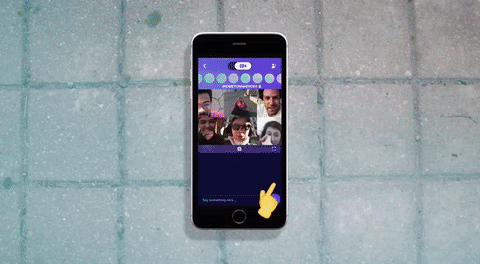
Though there’s no current monetization plan, you can imagine Airtime suggesting branded content for you and your friends to view, like movie trailers, or social media stars making clips with product placement.
The Next Frontier Of Presence
Airtime is addictive, but also a tad overwhelming. There are so many faces and options packed into the screen that the app can feel exhausting. It’s basically the closest thing you can get to an immersive social experience without a VR headset, though rapidly-flowing rooms can make you yearn for break. But most popular content mediums seem intense at first, from color TV and video games to the augmented reality on the horizon.
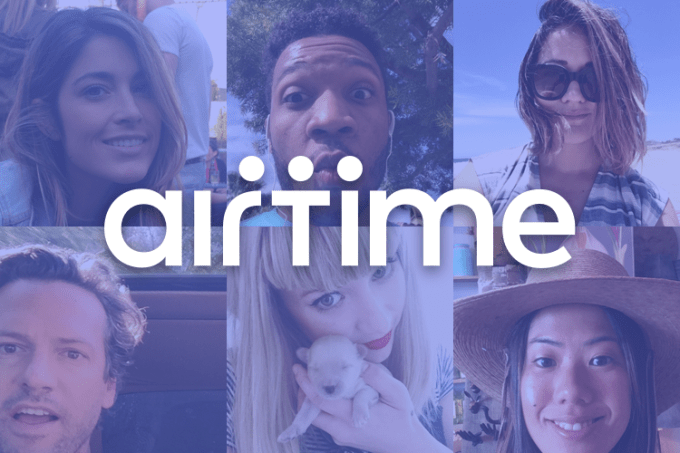
If messaging is for planning what you do offline, and Facebook is for sharing those offline experiences online, Airtime aims to create a place on the Internet, for experience the Internet, together. The trick will be forging a new behavior pattern. This isn’t blasting content to thousands of people, sliding it to one, or jamming it into a utilitarian message thread.
Airtime will have to convince people to hit the sweet spot of building a 10, 20, or 50 person room so there’s always something going on and always something to come back for.
Parker tells me “searching to not feel lonely isn’t what I was looking for, but it was what I found on the Internet — something that was since destroyed, that was chipped away” by the very social network he helped create: Facebook.
Perhaps he’s spent the last five years building Airtime to make up for it.
